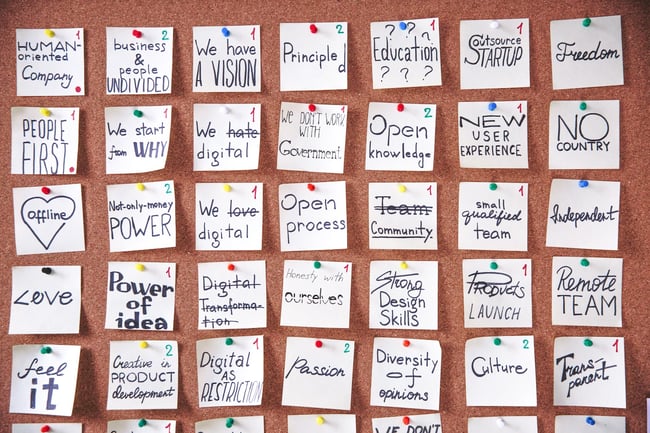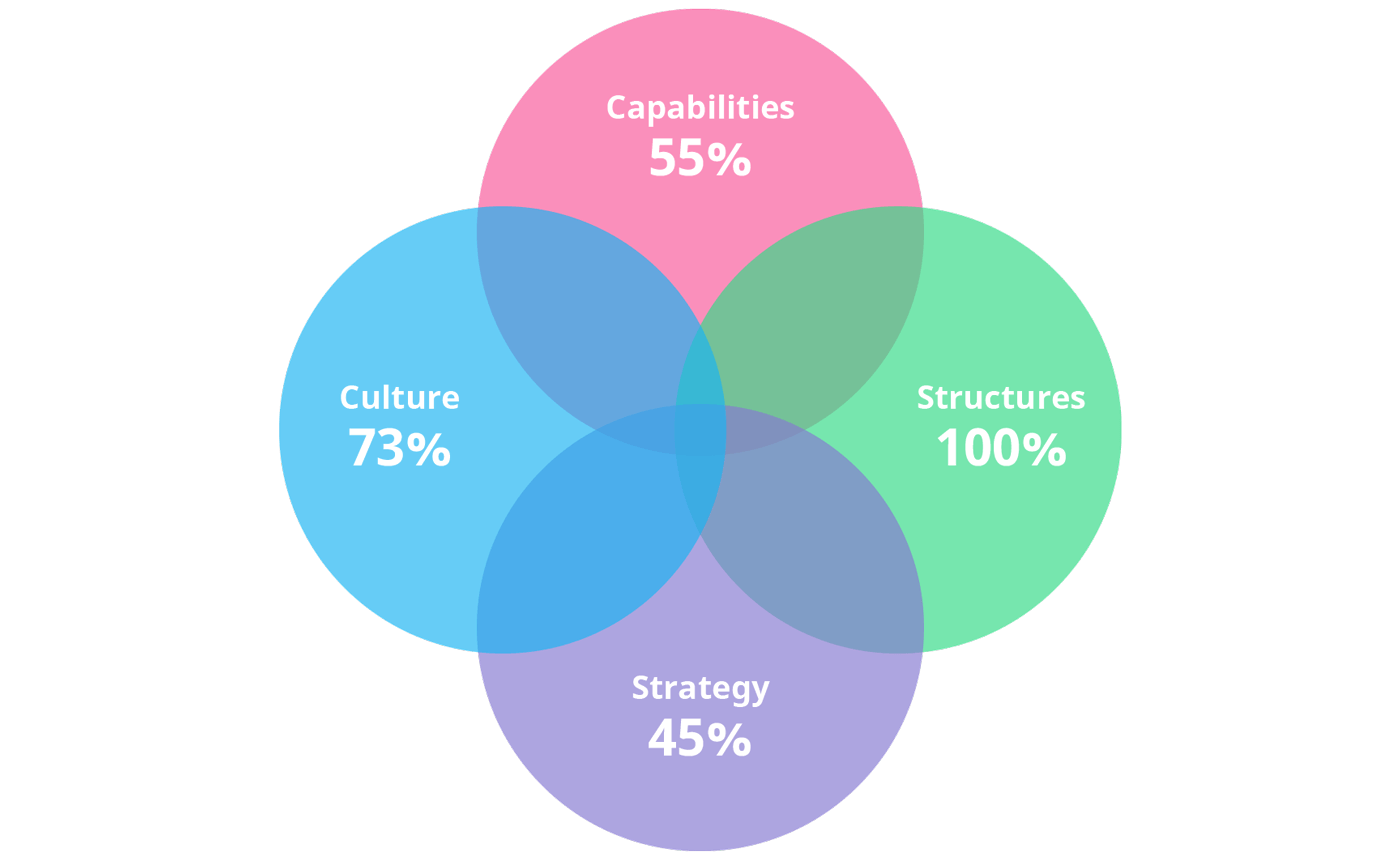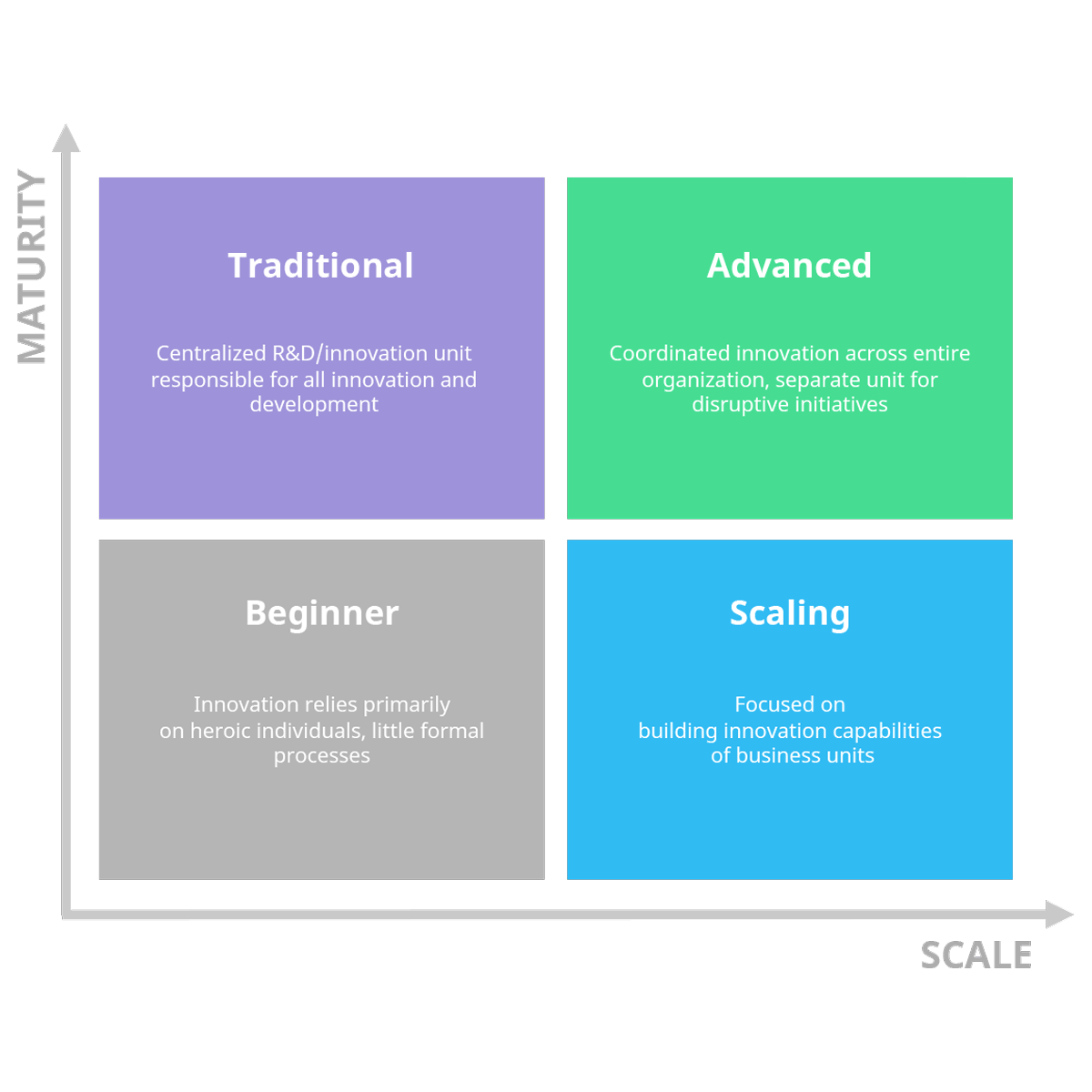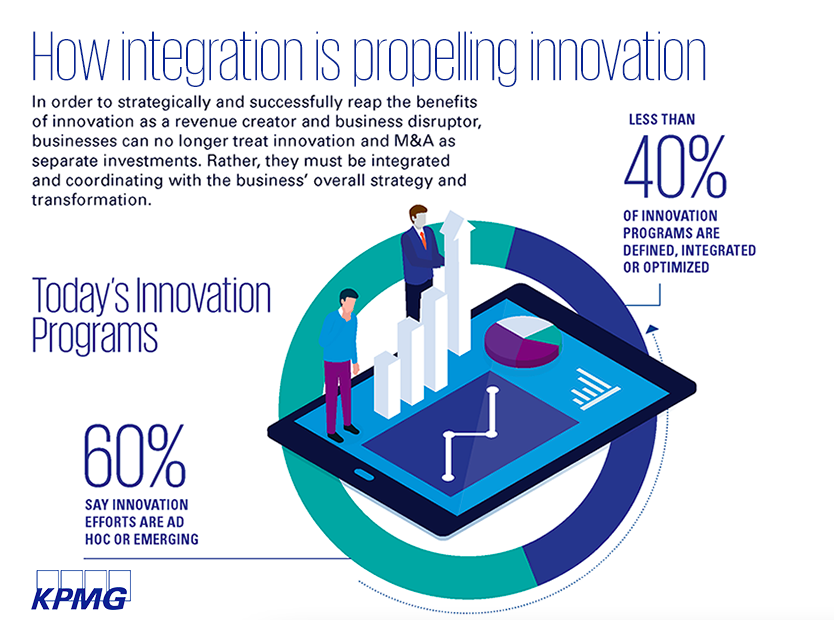How To Build a Corporate Innovation Program
In this day and age, when things move so fast and uncertainty and changes are inevitable, organizations of all sizes acknowledge the need to increase their investments in innovation. In fact, an Accenture research reports that investments in innovation are expected to increase 1.8X in the next five years.
However, just increasing budgets for innovation doesn’t necessarily lead to better results. Even though the interest in corporate innovation programs has grown, the focus is too often on small initiatives, and not on holistic approaches.
As you may know, having one or two good innovation initiatives is not enough for a successful innovation program. So, today we’ll go through some of the key steps and requirements for successful innovation programs. We’ll explain more in detail what an innovation program means, and how to go about it.
Table of contents
 What is an innovation program?
What is an innovation program?
Before going deeper into this topic, we should clarify that successful corporate innovation is not just about a well implemented innovation program.
That’s why it’s also important to explain what we mean by innovation program. Usually, the discussion around innovation programs is focused mostly on specific innovation initiatives, such as accelerators, incubators, innovation hubs.
These initiatives can of course be part of your portfolio of activities, but if you just focus on them, you might miss the forest for the trees.
An innovation program is a portfolio of initiatives built around an innovation strategy aligned with the organization’s business goals. To pursue an innovation program, the portfolio should adhere to a set of policies and actions aimed at achieving your goals.
In short, an innovation program is the concrete manifestation of your innovation strategy. Now, some might think, what is an innovation strategy and how is it different from a corporate strategy?
An innovation program is the concrete manifestation of your innovation strategy.
Well, the corporate strategy tells you where you want to be in the future and the innovation strategy simply outlines the role innovation needs to play in helping you get there.
Without an innovation strategy to guide them, innovation programs can easily turn out to be little more than a collection of bets without a clear direction and are likely to fall short of expectations.
The theory is simple but in practice, things are more complex. Most failures of innovation programs are attributed to a combination of factors. This is something we noticed after looking at a dozen of studies on what impacts innovation in a positive or negative way.

We identified as many as 13 different elements spread across all areas of innovation. The practical aspects such as processes, decision-making and organizational structures were the most predominant factors.
Even though some aspects are more common than others, there isn’t a single factor to point at, but rather a combination of several. In effect, you need to balance structures, capabilities, culture, and strategy to increase your chances to succeed. And part of this balance is the alignment of business goals and your strategy.

Now the question that arises, is how to build an innovation program and avoid these common pitfalls, while finding the right balance between all aspects involved in innovation?
4 steps towards an innovation program
As mentioned, for innovation programs to succeed you want to integrate all four aspects of innovation: capabilities, structures, culture, and strategy. This alignment will look different from case to case.
For example, if you’re looking into breakthrough innovations, your strategy, structures, processes, and capabilities will look different from those that would work with incremental innovations.
We also briefly introduced the topic of building an innovation program in our Q&A series.
But let’s take things one step at a time and look into the practical steps of creating an innovation program.
1. Have a practical innovation strategy
A good innovation strategy is practical and considers the organization’s business objectives. Unless you make these things a priority, you won’t see things moving in the right direction.
If you don’t have these things in place or the current strategy is too abstract, you should work with top management to clarify the goals before starting on the program.
This will also give you a better understanding of the current state of the organization in terms of innovation. Knowing your starting position will help you determine how to get where you want. In this case you can use a tool like the innovation maturity matrix.
The innovation maturity matrix is a framework that helps you illustrate where you are by considering two important variables: maturity and scale. With the innovation maturity matrix, we can classify innovators into beginners, traditionalists, scalers, and advanced.
To understand how the matrix works, we can simply look at the most successful companies out there: Amazon, Google and so on. While they innovate in different ways, they all do it at a large scale, across all parts and levels of the organization.
 To use this framework, you position your organization on the scale so you can assess your maturity level (all the innovation processes, decision-making and organizational structure, and the skills and resources), and the scale at which innovation is present within your organization (how widespread and embedded innovation is in the culture).
To use this framework, you position your organization on the scale so you can assess your maturity level (all the innovation processes, decision-making and organizational structure, and the skills and resources), and the scale at which innovation is present within your organization (how widespread and embedded innovation is in the culture).
The innovation maturity matrix helps you illustrate the big picture. You visualize your current position, look at what is missing to reach your goals, what capabilities you need to build, then break it all down into smaller, achievable objectives.
Now you might ask yourself, how is this linked to an innovation program and how it helps in building one? It’s pretty straightforward. An innovation program can’t be built if you don’t have the capabilities for it. At most, you get stuck after every small initiative, and you don’t get too far.
So, if you want a solid program incorporated in your organization’s strategy, you need to have a clear understanding of the capabilities at hand so you can start building the capacity required for innovation.
And this takes us to the next step in the innovation program.
2. Turn practical goals into an actionable roadmap
We can’t stress enough how important it is to have practical goals. Unfortunately, many companies don’t articulate their strategy well enough and, consequently, their goals, or simply they don’t act on them. To avoid falling in the same trap, you can have a roadmap that tells you what to do.
Successful innovation programs require a systematic process to plan, prioritize, and execute different initiatives. An innovation program should consist of different streams of activities that take place simultaneously.
 For example, at the same time you’d have a team that works on a prototype while another one is researching a new technology to support the development of your product. Then someone might be running an idea challenge to find solutions to specific problems. All these can become messy, if they are not followed up carefully with a step-by-step roadmap.
For example, at the same time you’d have a team that works on a prototype while another one is researching a new technology to support the development of your product. Then someone might be running an idea challenge to find solutions to specific problems. All these can become messy, if they are not followed up carefully with a step-by-step roadmap.
An innovation program should consist of different streams of activities that take place simultaneously.
For that, we can take the practical approach of what Mark Johnson describes as “leading from the future”. What do you want to achieve in 5-10 years from now? You basically break the future goal into smaller ones and take a systematic and methodical approach to do that.
Let’s say your big goal is to become the industry leader in the next 5 years. That’s a pretty big goal, and not a very specific one. So, you start breaking it down.
To get there in 5 years, you need a certain revenue in 4 years, which means you need a bigger team and two product lines. For that, in 3 years how many customers would you need for those products? You take it down to the closest, most feasible deadline and consider what is achievable in the short-term, like investing in an area that will make it possible to launch the new products in one year.
You won’t have all the answers so far in advance, and you don’t have to. But it’s good to have a mix of long-term projects and short-term ones, that bring quick results.
This practice will help you see what touch points are necessary and will give you an overview of the resources you need and the timeline to follow.
Without the necessary support, your innovation program won’t get too far. So, these small, reachable goals will win people over, increase the trust in the innovation initiatives, and help secure more resources for the future.
Through these small goals you can start building the capabilities required for the future and you’ll be able to show progress and tangible results.
3. Clear communication
When you communicate the program clearly, as well as the goals and vision you have in mind, you’re already one step ahead. Unclear communication can lead to misunderstanding and people could see a high-level program for innovation as a threat to their power within the organization or to their personal interests.
That’s why it’s good practice to communicate the “why” of the innovation program, what is at steak and what are the future aspirations. Also, how this will happen and bring benefits to the entire organization.
For example, in the case of an idea challenge or an idea management process you want people to get involved and participate. For that to happen, they should first understand the role and value of innovation and how that benefits them directly.
So, remind them why it’s important for them and for the organization to get involved, how their participation can bring value, what is expected from everyone and how things are progressing.
Usually, innovation is not part of everyone’s job description, so it doesn’t come naturally for everyone to change mindsets as soon as they start working on a new initiative. That’s why you should also take the responsibility of becoming a supporter, to teach and inspire them to become innovators.
4. Build the capabilities of the organization
When we speak about capabilities, we usually refer to the resources, human and financial as well as the processes and structures that enable innovation. Even though the term is mostly used as an umbrella to cover different abilities and resources, it revolves primarily around people, because innovation relies on the knowledge, abilities, and skills of those who make things happen.
In the context of innovation programs, we can think of two different capabilities you would need to develop.
First, those required for the short-term, immediate goals that can support innovation initiatives. For example, if you’re working on developing a new product or service and you need to first build a digital prototype, you’ll need the people who know how to do that.
And second, the capabilities that support innovation on the long-term and across the organization. This is where the innovation maturity matrix we mentioned earlier comes in handy. It will help you acknowledge gaps where new capabilities need to be built.
In a recent HBR article, Rita McGrath talks about 7 archetypes for locating capabilities within the organization. So, for example, if you have a business unit prepared to focus on a specific venture, you can create a dedicated division within that unit.
 This is a great way of building capabilities and placing teams within an organization according to goals and the current state. On the other hand, if you’re after a breakthrough innovation, or you are trying something new that is different from your core business, you can create a new division that acts independently.
This is a great way of building capabilities and placing teams within an organization according to goals and the current state. On the other hand, if you’re after a breakthrough innovation, or you are trying something new that is different from your core business, you can create a new division that acts independently.
As you can see, building capabilities and locating them on a timeline and in specific areas of the organization is closely linked to your goals and what you want to achieve.
And last, also consider the resource allocation. You don’t want to go halfway your program and realize you don’t have any budget left. There are various methods that help you decide how to allocate resources within your organization.
Some innovations might not have the same economic value which makes it that much harder to decide on any huge investments. That’s why it’s good to have more than one initiative and look into different innovation opportunities. Resource allocation should be decided early on when you draw your strategy and make the plan of your program.
Common pitfalls and challenges of innovation programs
Innovation programs could sometimes turn into innovation theater, but one of the biggest issues is that companies are often eager to rush into small, low-impact individual initiatives, instead of planning outcome-oriented innovation programs.
As already mentioned, there’s a wide range of factors that lead to unfruitful innovation programs, but we can’t overlook the importance of a holistic approach to innovation.
One initiative can’t transform your business the same way a well-thought innovation program can. The reason is simple. Each initiative that is included in a bigger program takes you closer to hit your goals. And even those that don’t work out, are still experiences to learn from.
One initiative can’t transform your business the same way a well-thought innovation program can.
However, if you are already on a good path and you’re working on a proper innovation program, there are still challenges ahead. We’ll list here some of the most common pitfalls and tips to overcome them.
1. Unclear goals and misaligned strategy
Strategy alignment and clear goals go hand in hand. As mentioned before, all your innovation activities should align with your business strategy. Unfortunately, it’s pretty easy to lose focus and get lost in the details. Even more, some companies go for the short-term fixes, create the hype, and lose sight of the long-term goals.
According to a KPMG survey, 60% of respondents said their innovation activities are ad hoc or emerging and 45% said their innovation and strategy is only somewhat connected, or not at all connected and aligned.

To avoid this, think of the future-back approach that Mark Johnson was talking about. Embrace both long term and short-term projects. Look into inspirational, high-level things you can do to support the bigger goals in the future and do more of the practical things that can move the needle in the short term but are still following the broader strategy.
2. Insufficient resources
A Gartner research indicates lack of resources as one of the top five barriers to innovation. Lack of funding is often cited as a major roadblock to innovation, but even if you don’t have the budget you’d want, it doesn’t mean that you should give up on innovation.
You’ll always face some sort of constraints, but as we were mentioning earlier, people are your most important resource, because they are the ones implementing the ideas. If your workforce has the right knowledge and skills, they can turn these constraints into a competitive advantage.
So, even though insufficient resources, especially financial ones, can become roadblocks for innovation, you can use them to unlock creativity and come up with outside the box innovations. Sometimes these constraints also come from unaligned goals, so companies have to remove these constraints and find new ways of achieving their goals.
For example, if you start with a small initiative that proves its value and growth potential, then you might be able to unlock additional funding which will allow you to scale up.
3. Lack of ownership
The lack of ownership is a problem that has its roots in the company’s culture. But it all starts at the top.
For employees to take ownership, leaders should clearly define goals, offer support, and leave them space to make decisions and be autonomous. At the same time, they always have to consider the bigger picture, to be on the look for roadblocks and opportunities and steer everyone in the right direction.
Leaders should clearly define goals, offer support, and leave them space to make decisions and be autonomous.
All can be dealt with more easily if the right processes and structures are in place. Such structures are also those that support the goals everyone is working towards. If they want innovation to happen, leaders and managers should find the right balance between governance and flexibility to enable their workforce to take ownership.
For example, in the case of an innovation initiative like an idea challenge you plan your resources, the audience involved and the roles of those in charge. This way you’ll clarify important aspect of your initiative and create a holistic view that can be explained to everyone.
You can plan your individual initiatives with a tool like the innovation planning canvas. This will help you set goals and identify all the elements required in your innovation or idea management process.
Conclusions
To wrap it up, we should remind you that successful innovation is not guaranteed by individual innovation initiatives. Instead, you need to commit to an overarching corporate innovation program that is integrating different activities to serve a common goal.
Ultimately, there is no set roadmap that you can just follow. It all depends on your organization, the goals you are striving for, your current maturity level and strategy.
Keep in mind that results won’t show up overnight, so be patient and monitor your progress. Innovation is always a lot of hard work, and so is creating and running an innovation program. Remember that innovation programs are after all just like any other innovation. As you implement it and move forward, you’ll need to iterate it.
If you want to build an innovation program, or manage innovation better we encourage you to try Viima. It's free for unlimited users!








